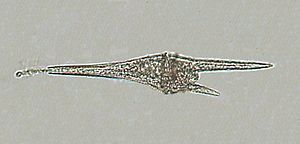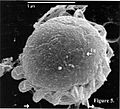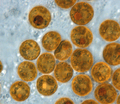Dinoflagellate facts for kids
Quick facts for kids Dinoflagellates |
|
|---|---|
 |
|
| Ceratium furca | |
| Scientific classification | |
| Domain: | |
| Kingdom: | |
| Superphylum: | |
| Phylum: |
Dinoflagellata
Bütschli 1885
|
| Classes | |
|
Dinophyceae |
|
Dinoflagellates are a big group of tiny living things called protists. They are known for having two whip-like tails, called flagella, which help them move around. About half of them can make their own food using sunlight, just like plants. These are sometimes called a type of algae. The other half are predators, meaning they hunt and eat other small organisms. These are sometimes called protozoa.
Most dinoflagellates live in the ocean as plankton, which are tiny organisms that float in the water. But you can also find them in fresh water. Where they live depends on things like water temperature, how salty the water is, and how deep the water is. Many dinoflagellates live in symbiosis (a close relationship) with other creatures. Some can even glow in the dark!
Scientists have described about 1,555 different kinds of free-living dinoflagellates in the ocean. Overall, there are an estimated 2,294 living species, including those in freshwater and those that live as parasites.
Contents
Amazing Dinoflagellate Biology
Tiny Helpers: Zooxanthellae
Some dinoflagellates are called zooxanthellae. These tiny organisms live inside other marine creatures, like corals, jellyfish, and even some clams. They have a special relationship where both organisms help each other. For example, many reef-building corals rely heavily on zooxanthellae to get their food. The zooxanthellae make food using sunlight, and the coral uses that food to grow.
Red Tides and Glowing Waters
Dinoflagellates can sometimes multiply very quickly, creating huge groups called "blooms." When these blooms are very dense, they can turn the water a reddish color, which is why they are called 'red tides'. Some species of dinoflagellates produce harmful chemicals called neurotoxins. These toxins can kill fish and other marine life. They can also build up in shellfish like clams and mussels. If people eat these shellfish, they can get sick.
But not all dinoflagellate blooms are dangerous. Some dinoflagellates are bioluminescent, meaning they can produce their own light. If you've ever seen the ocean water glow blue at night when it's disturbed, it might be because of a bloom of these glowing dinoflagellates! They light up with short flashes when something moves through the water.
Dinoflagellate Cell Structure
Even though dinoflagellates are eukaryotes (meaning their cells have a nucleus and other complex parts), their nuclei are a bit unusual. They have some features that are different from other eukaryotic cells. However, they do have typical eukaryotic cell parts like mitochondria (which produce energy) and chloroplasts (which help with photosynthesis).
Dinoflagellates have many interesting and complex features. Some even have structures that look a bit like simple eyes! Their genetics and how their cells work are quite unique compared to other living things.
Dinoflagellate Fossils
Fossilized dinoflagellates are very useful for scientists who study the Earth's history. They help in dating and understanding different layers of rock. During their lives, dinoflagellates have a floating stage and also a tough, protective cyst stage. This cyst stage helps them survive harsh conditions, like winter, by settling into the sediment at the bottom of the water. Only these tough cysts can become fossils.
The oldest clear fossils of dinoflagellates have been found from the Silurian period. They became much more common during the Mesozoic era, which is sometimes called the "Age of Dinosaurs."
Related pages
Images for kids
-
Symbiodinium sp. (Dinophyceae): zooxanthella, a coral endosymbiont
-
Noctiluca scintillans (Noctiluciphyceae)
See also
 In Spanish: Dinoflagellata para niños
In Spanish: Dinoflagellata para niños












